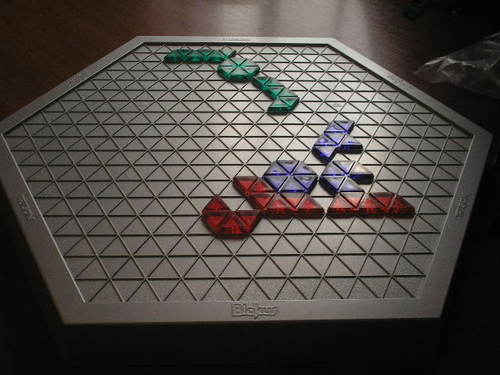A hexagonal grid and a triangular grid are duals of each other; that is, if you put a dot in the center of each hexagon, and connect them to each adjacent one, then you get a triangular grid:

Thus, playing on the vertices of a triangular grid is equivalent to playing in the spaces on a hexagonal grid, and likewise playing on the vertices of a hexagonal grid is equivalent to playing in the spaces on a triangular grid. An example of this is the game Hex, so named because of the hexagonal grid it is played on; however, you can also play it on a triangular grid by playing it like Go, on the vertices instead of the spaces.


One of the big difference between playing (in the spaces) on a hexagonal grid and a triangular grid is that in a hexagonal grid, each space is connected to six spaces around it; in a triangular grid, each space is connected to only three. This can significantly limit the number of options, if for instance you are only allowed to move to adjacent spaces, or only are allowed to make connections to adjacent spaces. A square grid gives you four connections, or eight if you can move or connect diagonally. A hexagonal grid gives you six. In many game designs, only have three moves or connections available is likely to be fairly limiting, though it may be possible to do something interesting with that.
There are games played with triangular grids. One example that comes to mind is Blokus Trigon. This is an interesting case, as each piece consists of triangles joined by their edges, but you join your pieces together by their corners, with the restriction that each piece must touch another of the same color on a corner but not on an edge. In the traditional square version of Blokus, this means that only two of the pieces which touch at a given intersection may be the same color; while in the triangular version, you have 6 spaces around each intersection, and thus can fit three pieces of the same color in. In this way, it manages to take advantage of both the triangular and hexagonal properties of the triangular grid.

Another example of using triangular and hexagonal boards is attempting to play Go on both. Xah Lee has some notes on how that works. As Go is played on the intersections, not in the spaces, each piece connects to only three others on the hexagonal board, and thus each piece has only three liberties, while on the triangular board, each space connects to six others. In the hexagonal version, only three spaces means that each piece is very vulnerable to capture; the game is very unstable. In the triangular version, each piece has lots of liberties, and is quite hard to capture. It sounds like for Go, 4 connections really is the ideal balance for just enough risk to have good tactical battles, while enough stability to be able to form live groups and be able to think more about strategy.
In summary, triangular grids are used occasionally, but I believe that in many cases they provide too few options or connections to provide interesting strategic play. However, if you're interested in designing games, perhaps you should take that as a design challenge; try to design a game that takes good advantages of the limited number of options a triangular grid gives you.
Image credits




